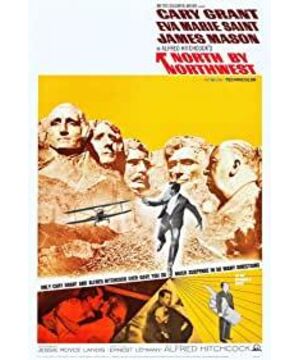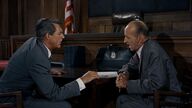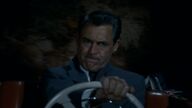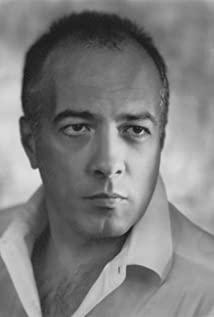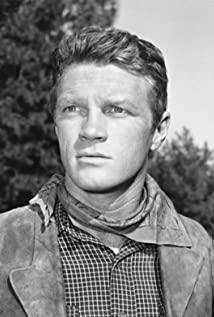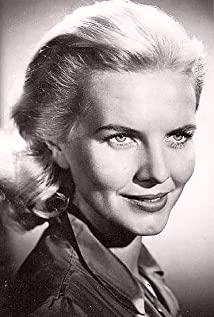The author regards "North by Northwest" as a classic Hollywood narrative film and carefully studied the operation of this film. First of all, this is a typical genre movie. Although Hitchcock has always claimed that he made thrillers, not mystery films. However, the author believes that the film still uses the plot mode of the detective story. A detective protagonist represents the perspective of the audience to solve the mystery created by the film. The thriller emphasizes suspense and surprise effects, and encourages the director to mislead the audience in the plot. Therefore, "North by Northwest" is a mixed type of the two film types.
Like most Hollywood movies, "North by Northwest" adopts a two-line narrative model. One is that a group of spies misunderstood that Roger Sohir, the representative of the advertising business, was George Kaplan, an American intelligence agent. Although the group of spies has been unable to catch him, Sohir himself has become the main suspect in the murder they committed. Therefore, he must escape the police and try to find out the real George Kaplan. Unfortunately, in fact, there is no such person as George Kaplan. This is just a bait set by the United States Intelligence Agency (USIA). Another narrative line is that George Kaplan meets Eva Conda, and then a romance story that is indispensable to mainstream movies occurs between the two.
In addition to using the two-line narrative mode, the middle mood section of the film contains many traditional narrative conventions. For example, the "search" mode: Thorhill sets out to find Kaplan. The "journey" model: Thorhill travels all the way from New York to Chicago, and then to Ruby City in South Dakota. Change all the way to various transportation such as taxis, trains, trucks, police cars, buses, moats and airplanes.
In order to make the complex plot woven by various narrative conventions look reasonable and consistent and easy to understand. First of all, the film established a precise timetable, including four days and nights: one and a half days in New York; the second night to catch the train to Chicago; the third day in Chicago and Perry Station; the fourth day in President Hill. Secondly, the protagonist must maintain a unified image and personality. The role of Gary Grant consolidates this image as an advertiser's wit, gentleman, elegance, and full of masculine charm. Once again, the repeated motif also makes the film have Unified tonality. The traps that Sohir was caught in were all high up: the car almost fell into the cliff; climbed up to Van Dan’s villa on the cliff; and finally hung with Eva on the stone face carved out of the president’s wall. Thorhill's constant change of transportation also forms an important motif.
The unity of external narrative alone cannot explain the emotional impact of the film. For the continuous creation of suspense and surprises in the film, we need to use the concept of hierarchy of knowledge created by Bodwell to analyze. The plot provides the scale of the scope of the story content to form a cognitive level. The easiest way is to ask: "Who knows what when". In "North by Northwest", three cognitive levels of the CIA, the audience, and Sohir are formed. The director's narrative arrangement is interspersed between these three levels. The most direct way to manipulate the audience’s cognition in this film is through a visual subjective lens (optical POV). This strategy limits the audience to know only what the character knows at that moment.
For example, at the beginning of the film, the shots of the film are mostly subjective shots of Sohir. The audience can only see what he sees. The audience's cognitive ability is the same as that of the protagonist. The audience, like Sohir, hopes to find out why he was mistaken for Kaplan as soon as possible. The film uses this strategy to introduce the first suspense of the film: Who is Kaplan? The audience's level of awareness was limited by the film for 38 minutes. When the patience of waiting was almost lost, the film freed our vision from Saohir's perception ability through a panoramic shot of Sohir's escape. The audience came to the CIA and learned the real secret of Kaplan's identity, while Thorhill was still on the way to escape. At this moment, the audience's cognitive ability surpasses the protagonist. The change in the audience’s scope of understanding provides a surprising effect to the plot. We have more story information than the protagonist. In the following, every time Thorhill tries to find Kaplan, it will trigger "Will he find this?" The suspenseful atmosphere of "facts".
In the subsequent plot, the audience's cognitive ability surpassed the protagonist many times. For example, when the male protagonist escaped from the police on the train with the help of the female protagonist, the audience was immersed in an affair just like the male protagonist at first. However, when the heroine trustee stuffed a small note into another wing. The camera opened the note with his hand, and it said: "What should I do with him tomorrow morning?" As soon as the camera backed away, the audience immediately discovered that the person reading the note was the spy who was chasing him. It turned out that Eva was also a spy. A member of the group. And Thorhill didn't know this fact until ten minutes later in the film. It was in these ten minutes that the director arranged the famous climax scene in the film, and Thorhill was assassinated by a plane.
In another scene in the film, the CIA professor informs Sohir about Eva's undercover status, and they make a plan to help Eva regain the trust of the spy leader. The audience's cognitive ability was reduced to the lowest level in this scene. What we can see is the conversation between Sohir and the professor before boarding the plane, and the specific plan is estimated to be made on the plane. This is a plan that the CIA knew, the hero and heroine knew, but the audience and the villain didn't know it. So when they finished their plan to meet again in the woods, the film created another surprise.
For another example, what happened in the last part of the film in the Presidential Villa at the foot of the mountain is the first time that Thorshill has known more than his characters in the film. He discovered the ins and outs of the smuggling and found out that the villain was about to kill Eva. As a result, the film returns to the visual narrative dominated by Sohir's subjective lens at the beginning of the film, and the audience is guided to pay attention to the success of the male protagonist. At this time, the restricted clue was the CIA's actions, so when their lives were hanging by a thread and the audience did not know what to do, the CIA appeared and staged a classic last-minute rescue routine.
In short, the director always controls and changes the cognitive range of the characters in the film and the audience, and cleverly arranges the cognitive level, creating suspense and surprise effects in a series of "possible" and "accidental" events. This constitutes the dramatic tension of this film and Hitchcock's film.
In summary, in this analysis of "North by Northwest", the two authors put forward the core concept of "cognitive hierarchy". Film artists control and mobilize the audience's emotions in watching movies by mastering the level of cognition. This is the core creative technique of film "suspense". We can push this concept to all movies of the same genre that create suspense to attract audiences. The contribution of this article is to start from the micro-text analysis to make the vague and suspenseful atmosphere that originally existed only in the audience's perception transparent, and make it a creative method that can be universally imitated. That is, the excavation of a magical Hitchcock can be copied into countless "Hitchcock" movie genes.
Literature
David Bodwell, Christine Thompson: "The Art of Cinema: Form and Style" (Illustrated 8th Edition), World Book Publishing Company, October 2008, 1st edition;
David Bodwell: "Movie Poems" Study", Guangxi Normal University Press, August 2010, 1st edition;
View more about North by Northwest reviews


